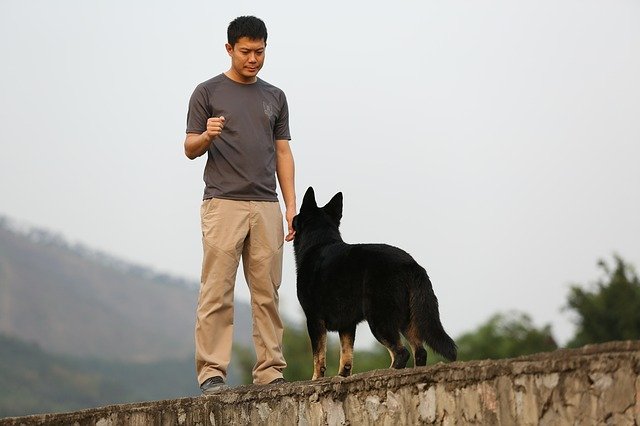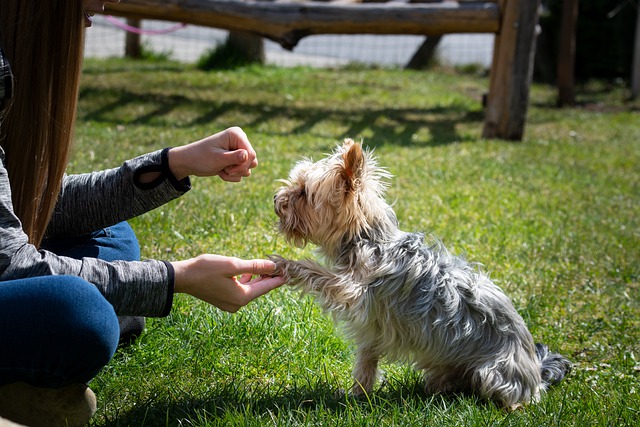
(via: https://pixabay.com/photos/shepherd-training-harmony-dog-man-3494519/)
Having a dog is a wonderful experience. As a result, it should come as no surprise that over 60 million US households have a dog. They are not only fun to have around, but are fiercely loyal and can provide companionship to anyone. It can also be a lot of fun to pick up toys, accessories and gear for your dog from sources like Furry Friends Gear to help give them the best life experience possible.
However, while dogs can be a joy to have around, not all dogs are inherently well-behaved. A misbehaving dog can be destructive, annoying, or even aggressive in some cases. As a result, training your dog is very important. Unfortunately, this is often easier said than done. However, there are many places to buy restraint, not only basics like Dog Collars and leads but also muzzles and harnesses too. This will help with the training, but it is unlikely you will be able to train on your own if your dog is acting up, so perhaps you can look for a training specialist as well.
In an effort to help you out, this guide is going to go over a few basics when it comes to training your dog successfully.
Stay Calm and Positive

(via: https://pixabay.com/photos/dog-small-dog-training-yorkie-5191526/)
An important aspect of training your dog is to stay calm and positive. While it would be lovely if your dog understood everything the first time and was flawless, this isn’t likely to be the case. Your dog will mess some things up and things will certainly not go according to plan. But instead of getting mad and freaking out, it is important to stay calm and remain positive.
The tone you use and how you approach training can have a big impact on how successful it is. While a harsh correction or yelling might work in the short term to get your dog to stop doing something or pay attention, it won’t be effective long term and simply isn’t a very nice way to go about things. If your dog is trained using aggressive tactics or tones, it is more likely they will become aggressive themselves.
If you can use positive reinforcement and show your dog that you are happy with them, they will often repeat the process in the future. While some might do the right thing inherently, others may need to be provided treats during the early days of training. You can buy some food dispensing dog toys for this occasion, and let your dog play with them for a treat as a form of positive reinforcement.
Keep Sessions Short
In most cases, it is a good idea to keep training sessions relatively short. Even if the dog were to be signed up for a Gateshead Dog Training class or a similar program, the trainers there may have the same opinion too. While this can vary on a case-to-case basis, keeping them around 10-15 minutes is ideal. Training your dog will not happen overnight. Trying to put in multi-hour days to teach your dog a new skill or behavior in only a day or two simply will not work. It takes time for lessons to stick, and it is not something you can rush.
So once or twice a day, take your dog aside and attempt to train them. This could be training them to sit, to do their business outside, to stay, to come or anything in between. Not only are these short sessions easier to fit in your day, but most dogs have relatively short attention spans. If the training goes too long, they could become bored or restless, and the lessons will become more difficult.
Minimize Distractions
Distractions are often the biggest enemy of a successful training session. As a result, be sure to choose a time and location where you can train free from distraction. Things like spouses, children, or even the sounds and sights of the outdoors can make it difficult for dogs to focus. Choose a time where you don’t feel rushed and when you won’t be interrupted at all.
A storage room, your basement or a spare bedroom are generally good places to train where you can be alone and free from any distractions. If your dog is distracted, it could multiply the time it takes for lessons to stick by a lot.
If you simply cannot train in a place with no distractions, take steps to help your dog ignore distractions. While this isn’t always easy, it can be worth it for a well-trained dog.
In conclusion, we hope that this article has been able to help you train your dog successfully.
Comments are closed.